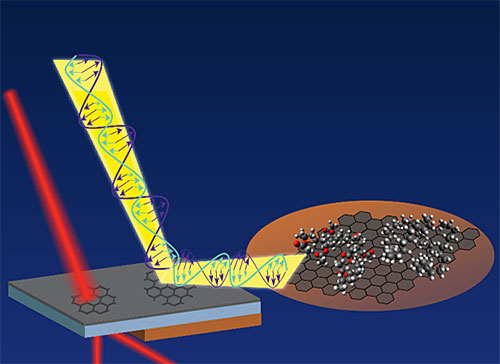The Guiding Power of Graphene in Polymer Films
January 20, 2021
 enlarge
enlarge
Illustration of the infrared reflection absorption spectroscopy experiment showing polarized light interacting with molecules in a polymer-graphene composite.
What is the scientific achievement?
A collaborative team of CFN users and staff demonstrated how graphene induces polymer chains to rearrange and create favorable electrostatic interactions. The scientists combined optical transmission, Raman spectroscopy, and infrared reflection absorption spectroscopy to deduce the molecular structure of the polymer-graphene composite films.
Why does this achievement matter?
Conductive transparent film coatings like graphene-polymer composites hold promise for technologies requiring lightweight, strong, and flexible transparent electrodes. This work advances the understanding of graphene-polymer surface interactions and how they can be engineered for use in flexible electronics, energy storage, and biointerfaces.
What are the details?
For the first time, researchers obtained direct evidence of graphene-induced molecular reorientation in polymer films using polarization-modulated infrared reflection absorption spectroscopy (PM-IRRAS). By creating favorable electrostatic interactions, graphene-polymer interfaces can be controlled by varying polymer and solvent composition. After transfer of unmodified graphene from copper onto a polymer substrate, polymer chain rearrangement relative to the orientation at the polymer-copper interfaces is observed using PM-IRRAS. Transfer success is characterized using both optical transmission measurements and Raman spectroscopy to quantify the transfer fidelity—that is, the graphene coverage fraction. Taken together, oxygen-containing poly(ethylene-co-vinyl acetate) shows more polymer chain rearrangement and better graphene coverage compared to oxygen-free polyethylene. Polymer composition seems to dominate graphene-polymer interactions, while solvent choice has a smaller effect on transfer quality. These results are the first direct measurement of this effect and point toward the possibility of engineering graphene-polymer interactions for specific applications.
CFN Capabilities
The CFN Proximal Probes Facility was used for polarization-modulated infrared reflection absorption spectroscopy and Raman spectroscopy.
Publication Reference
A. J. Carr, A. Head, J. A. Boscoboinik, S. R. Bhatia, M. D. Eisaman, “Direct Evidence of Graphene-Induced Molecular Reorientation in Polymer Films”, Adv. Mater. Interfaces 7, 2000113 (2020).
Cover: https://onlinelibrary.wiley.com/doi/abs/10.1002/admi.202070066
Future technologies will increasingly integrate multifunctional conductive transparent film coatings like graphene-polymer laminar composites. The combination of mechanical strength, flexibility, optical transparency, and electrical conductivity in such films make them likely components in applications requiring lightweight, strong, and flexible transparent electrodes. In article number 2000113, Matthew D. Eisaman, Amanda J. Carr, and co-workers elucidate graphene-polymer surface interactions that can be engineered to optimize these next-generation applications.
Acknowledgement of Support
This research used resources of the Center for Functional Nanomaterials, which is a U.S. DOE Office of Science Facility, at Brookhaven National Laboratory under Contract No. DE-SC0012704. Partial support for A.J.C. was provided by the National Science Foundation through award CBET-1335787 and the Petroleum Research Fund award 55729-ND9.
2021-17665 | INT/EXT | Newsroom









